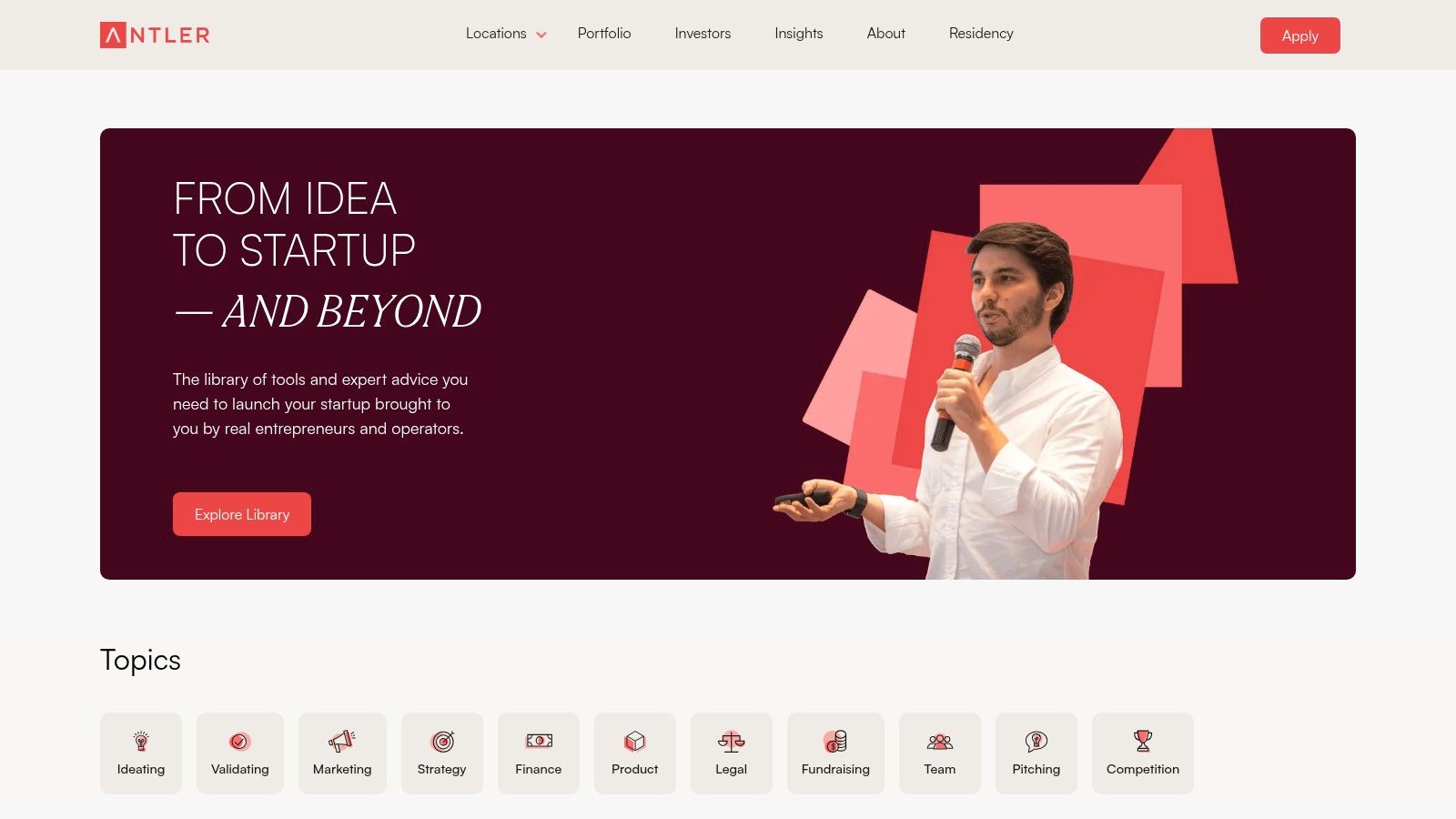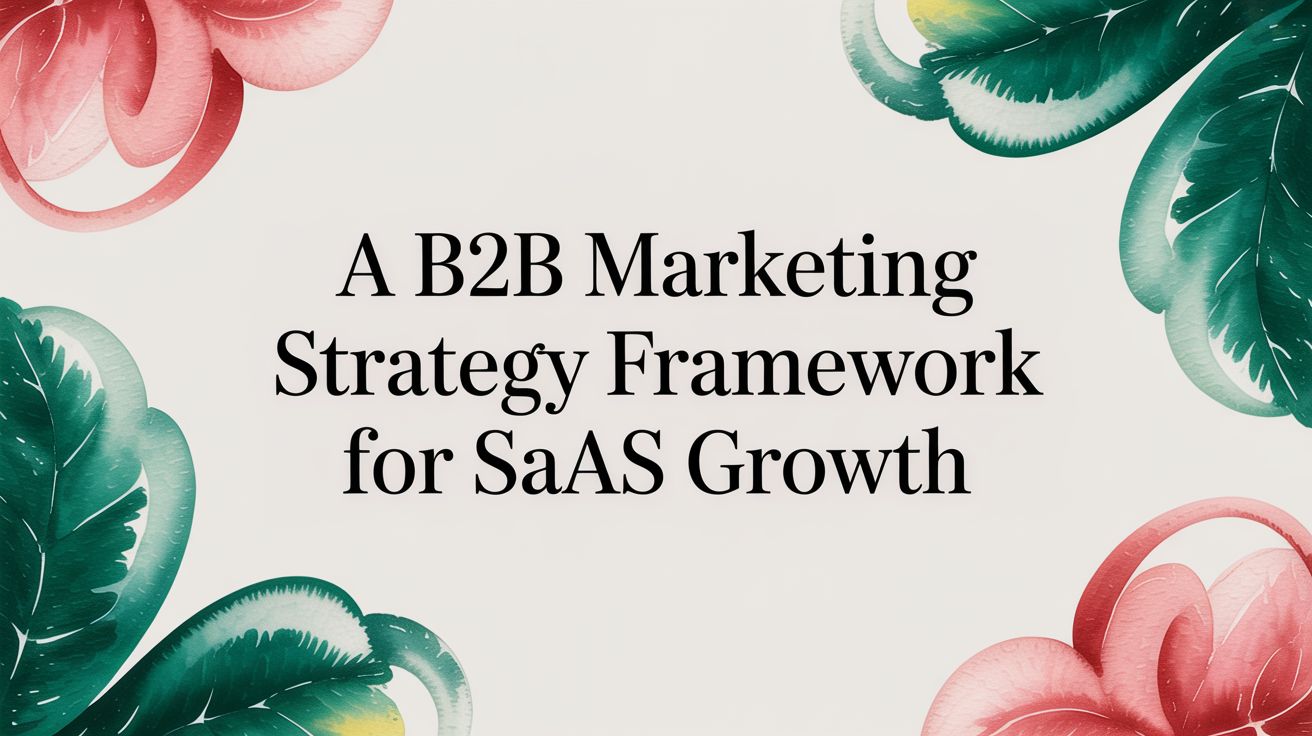Top 7 Minimum Viable Product Examples for B2B SaaS in 2025
July 28, 2025

Every legendary B2B SaaS company started with a single, audacious idea. But the path from a visionary concept to market dominance isn't paved with complex features and massive launch budgets. It's built on a leaner, smarter foundation: the Minimum Viable Product (MVP). An MVP isn't just a stripped-down version of your product; it's a strategic tool for learning, a direct line to your first users, and the most capital-efficient way to validate your core hypothesis. It’s about building just enough to solve a real problem and gather crucial feedback.
This article dives deep into powerful minimum viable product examples and the strategic thinking behind them. We won't just show you what was built; we will dissect why it was built that way. You’ll get actionable takeaways from real-world case studies, complete with screenshots and direct links, to see how the leanest startups laid the groundwork for massive success. Mastering the art of the MVP is step one, but getting it in front of the right people is equally critical. To truly embody the 'lean startup' philosophy, understanding how to gain traction efficiently is paramount. Explore effective strategies for acquiring early users with minimal ad spend to ensure your MVP makes a splash without breaking the bank. Let’s get started.
1. Antler Academy
Antler Academy offers a masterclass in learning from the greats. Instead of being an MVP itself, it's a powerful educational resource that dissects the most iconic minimum viable product examples from giants like Amazon, Meta (formerly Facebook), and Uber. For B2B SaaS founders seeking inspiration and a strategic roadmap, this platform is an essential first stop.

The platform shines by transforming legendary startup stories into actionable blueprints. It goes beyond surface-level narratives to reveal the core problem each company solved, the exact single feature they launched with, and the crucial lessons learned along the way.
Strategic Breakdown & Key Insights
Antler’s true value lies in its structured analysis. Each case study is meticulously broken down, allowing founders to see the direct line between a simple initial concept and a multi-billion dollar enterprise. The user-friendly interface makes navigating these deep dives effortless.
Key Takeaway: The world's most successful companies didn't launch with a suite of complex features. They launched by solving one specific problem exceptionally well. Antler Academy repeatedly proves that a focused, lean start is the foundation for massive scale.
How to Leverage Antler Academy
To maximize the value from this free resource, approach it with a specific goal. Don't just browse; actively analyze how the strategies of these giants can be adapted to your own B2B SaaS context.
- Focus on the "Why": For each example, identify the core user pain point they targeted. How does it compare to the problem your startup is solving?
- Deconstruct the "What": Note the stripped-down feature set of each MVP. This is a powerful exercise in ruthless prioritization for your own product roadmap.
- Apply the "How": Extract the validation methods used. Did they use landing pages, manual processes, or a simple prototype? These are replicable tactics for any early-stage venture.
This resource is completely free to access, making it an invaluable, no-risk tool for any founder. While the content is primarily text-based and limited to nine core examples, the depth and quality of the analysis make Antler Academy a standout educational platform for anyone studying successful product launches.
Website: https://antler.co/academy
2. Gravitywell
Gravitywell provides a high-level overview of some of the most classic minimum viable product examples, making it a perfect starting point for founders new to the concept. It offers concise summaries of five notable MVP stories, including giants like Spotify and Airbnb, distilling their journeys into easily digestible lessons.
This resource excels at simplifying complex startup histories. For B2B founders looking for quick inspiration, Gravitywell’s blog post highlights the critical role of focusing on a single core feature and relentlessly gathering user feedback during the initial stages of product development.
Strategic Breakdown & Key Insights
Gravitywell’s approach is about speed and clarity. The post avoids dense analysis, instead focusing on the single most important lesson from each company's launch. This makes it an efficient resource for understanding the core principles of lean startup methodology without a significant time commitment.
Key Takeaway: You don't need a perfect, feature-rich product to launch. The MVPs of today's biggest brands were often surprisingly simple, proving that a focused solution that solves a real problem is the most effective path to market validation.
How to Leverage Gravitywell
Use this resource as a quick-reference guide to reinforce foundational MVP principles. It’s ideal for a team brainstorming session or for founders who need to quickly realign their focus on what truly matters in an early-stage product.
- Absorb the Core Idea: For each example, identify the one key function that defined their MVP. How did Airbnb use photos and a simple payment system? How did Spotify test its streaming model?
- Focus on the "Who": Note the initial target audience for each MVP. These brands didn't try to appeal to everyone at first; they targeted a niche group to validate their concept.
- Embrace Simplicity: Use these examples as a filter for your own feature list. If a feature doesn't contribute directly to solving the core problem, it probably doesn't belong in your MVP.
This straightforward article is completely free to access. While it offers less depth and fewer examples than more comprehensive platforms, its value lies in its directness, making it a great tool for grasping the essential philosophy behind successful B2B product launches. Learn more about effective marketing for B2B ventures to complement these product strategies.
Website: https://gravitywell.uk/blog/minimum-viable-product-examples
3. Shortcut
Shortcut’s guide to the MVP is less of a single tool and more of a comprehensive manual for product development. While Antler Academy focuses on a curated set of giants, Shortcut broadens the horizon by offering a detailed exploration of minimum viable product examples from diverse sectors, including companies like Dropbox, Duolingo, and Foursquare. It serves as a foundational text for founders who want to understand not just the "what" but the "why" behind the MVP methodology.
The guide excels by clearly defining the MVP concept and its different types before diving into specific case studies. It’s an educational piece that connects the theoretical framework of lean startups to the practical realities of launching a new product, making it a valuable resource for teams at the earliest stages of ideation.
Strategic Breakdown & Key Insights
Shortcut’s strength is its clear, educational structure. It methodically walks readers through the definition of an MVP, its core benefits, and then illustrates these points with well-known examples. The content is designed to build a strong foundational understanding, ensuring founders grasp the strategic principles before getting lost in feature details.
Key Takeaway: A successful MVP isn’t just a stripped-down product; it's a strategic experiment designed to test a core hypothesis with minimal resources. Shortcut's guide emphasizes that the primary goal is learning, not just launching.
How to Leverage Shortcut's Guide
To get the most out of this resource, use it as a strategic checklist for your own MVP planning. It’s a perfect starting point for team discussions about product strategy and scope.
- Clarify Your MVP Type: Use their definitions to identify which kind of MVP (e.g., Concierge, Piecemeal, Wizard of Oz) best suits your startup’s needs and resources.
- Benchmark Against Examples: Compare your initial product concept to the MVPs of companies like Dropbox or Duolingo. Are you focused on solving a single, high-value problem as they were?
- Validate Your "Why": The guide repeatedly highlights the learning aspect of an MVP. Use this as a lens to refine your own goals. What is the single most important assumption you need to validate with your launch? Defining this is a key step toward achieving product-market fit. Learn more about the product-market fit checklist on bigmoves.marketing.
This guide is completely free to access on the Shortcut blog. While it is text-heavy and lacks interactive elements, its thorough and well-organized content makes it an excellent primer for any B2B SaaS founder looking to master the fundamentals of lean product development.
Website: https://shortcut.com/blog/minimum-viable-product-examples
4. Minimum Code
Minimum Code offers a valuable collection of case studies on successful MVPs, providing a tactical playbook for founders. By examining ten well-known companies, including Slack and Instagram, it reveals the initial strategies that fueled their growth, making it a key resource for understanding flexible and responsive minimum viable product examples.
The platform stands out by emphasizing the iterative nature of product development. It doesn't just present the final successful product; it highlights the pivots, the learning loops, and the responsiveness to early user feedback that were critical during the MVP phase.
Strategic Breakdown & Key Insights
Minimum Code’s strength lies in its diverse range of examples from different sectors, offering a broad perspective on MVP strategy. The analysis focuses on practical takeaways, showing how a lean start can be adapted across various business models, from social media to B2B communication tools. This variety is crucial for founders looking for inspiration beyond their immediate industry.
Key Takeaway: Success isn't about getting the product perfect on day one. It’s about building a framework for learning and adapting quickly based on real-world user interaction. Flexibility is not a weakness; it's a strategic advantage.
How to Leverage Minimum Code
To get the most out of this resource, focus on the underlying principles rather than just the surface-level stories. The content is text-based and easy to navigate, allowing for quick consumption of key ideas. While some examples may overlap with other resources, the unique focus on iterative strategy provides fresh insights.
- Study the Pivots: Pay close attention to examples where the initial product idea evolved. How did user feedback drive that change? What can you learn about listening to your first customers?
- Analyze the Core Loop: For each case study, identify the core action users were meant to take. How did the MVP facilitate this single, essential loop?
- Apply the Iteration Mindset: Use these stories as a guide for your own development sprints. For more guidance on this process, explore this guide to building a minimum viable product.
This platform is completely free to access, making it a practical, high-value tool for any entrepreneur. The insights prove that a flexible and user-centric approach is fundamental to turning a simple MVP into a market-leading product.
Website: https://minimumcode.com/minimum-viable-product-examples
5. Soft Suave
Soft Suave provides a practical playbook through its blog, which details some of the most effective minimum viable product examples from the tech world. Rather than a complex tool, it’s a concise and focused article that serves as a powerful reference for founders, especially those in the web and mobile app space.
The post stands out by highlighting MVPs from well-known companies like Buffer and the innovative Pebble Smartwatch. It zeroes in on the practicalities of launching lean, making it an excellent resource for B2B SaaS founders looking to build cost-effective products without sacrificing core value.
Strategic Breakdown & Key Insights
Soft Suave’s strength lies in its simplicity and directness. The article explains not just what was built, but also the strategic thinking behind why certain features were prioritized and others were left out. It provides clear, actionable lessons from each example discussed.
Key Takeaway: A successful MVP isn’t about building a cheaper version of a full product; it’s about finding the fastest path to validate a core hypothesis. Soft Suave’s examples show that a single, well-executed feature can be enough to test market demand and secure initial traction.
How to Leverage Soft Suave's Insights
This resource is best used as a quick, inspirational guide to reinforce the principles of lean development. It’s particularly useful for teams brainstorming their own MVP strategy or looking for validation of a minimalist approach.
- Analyze Cost-Effectiveness: Pay close attention to how the featured startups minimized development costs. This is crucial for early-stage B2B founders managing a tight budget.
- Study the Feature Set: For each example, identify the single most important feature that defined the MVP. How does this compare to your own product’s core functionality?
- Apply to Your Niche: While the examples are diverse, consider how their launch strategies could be adapted. For instance, the principles from a consumer app like Buffer can inform the development of a B2B social media tool, and the learnings from e-commerce MVPs can be applied to any SaaS business with a transactional component, like those looking to grow their Shopify app.
Access to this article is completely free, offering valuable insights with no investment. Though the number of examples is limited and the focus is primarily on tech, its practical advice on cost-effective development makes it a worthwhile read for any founder in the B2B SaaS arena.
Website: https://softsuave.com/minimum-viable-product-examples
6. Connor Gillivan's Blog
Connor Gillivan’s blog offers an entrepreneur’s personal lens on iconic minimum viable product examples. Drawing from his own journey, Gillivan breaks down the launch strategies of household names like Twitter and Groupon, providing a relatable and actionable perspective that resonates with early-stage founders.
This platform stands out by blending well-known case studies with the practical wisdom of someone who has navigated the startup trenches. The content feels less like a textbook and more like a mentor sharing hard-won lessons, making complex MVP concepts feel accessible and achievable.
Strategic Breakdown & Key Insights
Gillivan's strength lies in his narrative-driven analysis. He explains not just what these companies did, but also the entrepreneurial mindset behind their decisions. The ten case studies are presented in a clear, easy-to-digest blog format that highlights the core function and the validation process for each MVP.
Key Takeaway: Behind every successful MVP is an entrepreneur who was willing to test a core assumption in the simplest way possible. Gillivan’s examples reinforce that validation, not complexity, is the most critical ingredient for a successful launch.
How to Leverage Connor Gillivan's Blog
This free resource is perfect for founders seeking both inspiration and a dose of reality. The personal tone makes it an engaging read that can spark new ideas for your own product development and initial go-to-market strategy.
- Study the Storytelling: Pay attention to how Gillivan frames each startup's journey. Use this as a model for how you articulate your own startup's vision and value proposition.
- Identify the Core Assumption: For each example, pinpoint the single most important belief the founders were testing. Was it that people would share short status updates (Twitter) or buy pre-paid deals (Groupon)?
- Connect to Your Marketing: The lessons here go beyond product development. They are foundational to building an effective marketing strategy for your startup, as they prove the power of a clear, focused message.
While the blog is limited to ten examples and may not offer the same analytical depth as a dedicated academy, its authentic voice and practical insights make it a valuable stop for any founder. The content is completely free and serves as a powerful reminder of the lean principles that drive startup success.
Website: https://connorgillivan.com/minimum-viable-product-examples
7. Devathon
Devathon provides a valuable perspective for founders by curating a listicle of iconic minimum viable product examples, drawing lessons from household names like Amazon, Etsy, and Foursquare. Rather than being a single case study, it serves as a high-level overview of different MVP strategies, making it a great resource for initial brainstorming and strategic orientation.
The platform’s strength is in its synthesis of well-known startup journeys into digestible narratives. It focuses on the evolution from a simple concept to a market leader, highlighting how initial products were designed to test a core hypothesis and gather crucial user feedback before scaling.
Strategic Breakdown & Key Insights
Devathon’s analysis emphasizes the journey beyond the initial launch. Each example is framed not just by its starting point but by its subsequent adaptation and growth, offering insights into how an MVP is not a one-time launch but the first step in an iterative process. This focus on product evolution is what sets it apart.
Key Takeaway: A successful MVP isn’t just about launching lean; it’s about creating a foundation for learning and adaptation. Devathon’s examples consistently show that the most critical phase comes after launch, where user feedback dictates the path to product-market fit and scale.
How to Leverage Devathon
Use Devathon's blog post to gain a broad understanding of different MVP archetypes before diving deeper into a specific strategy for your own B2B SaaS venture. It's a perfect primer for team alignment meetings.
- Categorize the Approaches: As you read, classify each example. Was it a "Concierge" MVP like Food on the Table or a "Piecemeal" MVP like Groupon? This helps in identifying patterns.
- Focus on the Pivot: Pay close attention to how companies like Etsy and Airbnb adapted their offerings based on early user interactions. What data did they use to make these critical decisions?
- Extract Scaling Lessons: Note the transition from MVP to a more robust product. The insights into how these companies managed growth are invaluable for long-term planning.
This resource is a free-to-access blog post, making it an excellent, no-cost starting point. While the content is purely text-based and covers widely-known examples, its clear focus on the post-launch evolutionary path provides a unique and practical lens for founders.
Website: https://devathon.com/best-minimum-viable-product-examples
Minimum Viable Product Examples Comparison
Your Blueprint for a Viable MVP: From Idea to Launch
The journey from a groundbreaking idea to a market-ready product is paved with strategic decisions, and as we've seen, the Minimum Viable Product is the cornerstone of that path. The diverse minimum viable product examples we've explored, from Antler Academy's educational platforms to Gravitywell's bespoke development and Shortcut's project management tools, all share a common thread: they started small, focused intensely on a core problem, and used early user feedback as their ultimate compass.
This isn't just about building less; it's about building smarter. It's about surgically identifying the one critical function that delivers immediate value and validates your core hypothesis. Your first version doesn’t need to do everything for everyone. It needs to do one thing exceptionally well for a specific someone.
Distilling the Core Lessons
Reflecting on the tools and strategies discussed, several key principles emerge for any founder ready to build their MVP:
- Focus is Your Superpower: The most successful MVPs, like those developed using frameworks from Minimum Code or Devathon, demonstrate a ruthless prioritization of features. They solve a single, painful problem before expanding their scope.
- Validation Over Assumption: Every example underscores the importance of treating your MVP as a learning vehicle. Your goal isn't immediate perfection; it's rapid validation. Use the insights from early adopters, as highlighted in Connor Gillivan's approach, to guide your next development sprint.
- The Right Tool for the Job: Your choice between a no-code builder, a development agency like Soft Suave, or an in-house team using a tool like Shortcut depends entirely on your specific circumstances. Consider your technical expertise, budget constraints, and speed-to-market requirements.
Your Actionable Next Steps
Translating these insights into action is what separates a static idea from a dynamic business. Here is your blueprint to move forward:
- Define Your "Minimum": Re-evaluate your product roadmap. What is the absolute smallest version of your product that can solve a real problem for your target user? Be brutally honest and cut everything else for now.
- Choose Your Build Path: Based on your resources, select the right tool or partner. If you need speed and have limited technical skills, a no-code platform might be ideal. If your product requires complex logic or integrations, a specialized development team could be the better investment.
- Map Your Feedback Loop: Before you even write a line of code or design a single screen, determine exactly how you will collect, analyze, and act on user feedback. This is the engine of your MVP's evolution.
Building an MVP can feel like navigating uncharted territory, but with a clear strategy, it becomes an executable plan. To guide you through the process, consider exploring an MVP Playbook for Startup Founders that offers practical steps and strategies.
Ultimately, the power of the MVP lies in its ability to de-risk your venture and accelerate your learning. It transforms guesswork into data-driven confidence. Embrace the principles of minimalism, focus, and rapid iteration. Your future customers aren't waiting for a perfect product; they are waiting for a solution to their problem. Go build it.
Ready to take your validated MVP and scale it into a market leader? At Big Moves Marketing, we specialize in crafting growth strategies for B2B SaaS companies, turning your initial traction into unstoppable momentum. Let us help you build the marketing engine that your product deserves. Big Moves Marketing.
%20-%20Alternate.svg)


%20-%20white.svg)